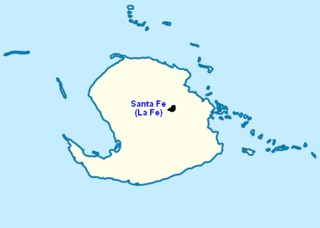
Administratively, Cuba is divided into 15 provinces and one special municipality. The current structure has been in place since August 2010, when the then-La Habana Province was divided into Artemisa Province and Mayabeque Province.

Isla de la Juventud is the second-largest Cuban island and the seventh-largest island in the West Indies. The island was called the Isle of Pines until 1978. It has an area 2,200 km2 (850 sq mi) and is 50 km (31 mi) south of the island of Cuba, across the Gulf of Batabanó. The island lies almost directly south of Havana and Pinar del Río and is a Special Municipality, not part of any province and is therefore administered directly by the central government of Cuba. The island has only one municipality, also named Isla de la Juventud.

Holguín is a municipality-city in Cuba. After Havana, Santiago de Cuba, and Camagüey, it is the fourth largest city in Cuba.

The Presidio Modelo was a "model prison" with panopticon design, built on the Isla de Pinos, now the Isla de la Juventud, in Cuba. It is located in the suburban quarter of Chacón, Nueva Gerona.
Juventud, a Spanish word meaning youth, or Juventude, its Portuguese equivalent, may refer to:

Santa Fe, also named La Fe, is the second largest town on Isla de la Juventud of Cuba.

Santurce is a barrio of San Juan. Its population in 2020 was 69,469. It is also the biggest and most populated of all the barrios in the capital city with a larger population than most municipalities of Puerto Rico and one of the most densely populated areas of the island .

Piratas de Isla de la Juventud, or simply Piratas de la Isla is a baseball team in the Cuban National Series. Based in Nueva Gerona, Isla de la Juventud, the Piratas reached the Finals of the 54th Cuban National Series, remaining as runners-up.
Michel Enríquez Tamayo is a retired Cuban baseball third baseman.
Juan Carlos Moreno Pérez is a shortstop with Isla de la Juventud and the Cuba national baseball team.
The Campeonato Nacional de Liga de Fútbol de Cuba is the top football division in Cuba. Currently, it is contested by 16 clubs and is divided into two tournaments – "Apertura" and "Clausura", with the last being the championship tournament. The champion of each tournament, decided via a playoff match ("Final"), are qualified to Supercopa Nacional de Fútbol de Cuba. The league currently has a fixed membership with each club being a representative of a Cuban province, which makes it one of the football leagues that does not have a promotion and relegation process.

Batabanó is a municipality and town in the Mayabeque Province of Cuba. It was founded in 1688.
José Lázaro Vázquez Xene is a Cuban artist specializing in ceramics and drawing.
Rafael Cabrera Mustelier Airport or Rafael Cabrera Airport is an airport serving Nueva Gerona, the capital city of the Isla de la Juventud special municipality in Cuba.

Surgidero de Batabanó, also shortened as Surgidero, is a Cuban village and consejo popular of the municipality of Batabanó, in Mayabeque Province. In 2011 it had a population of about 6,000.

The road network of Cuba consists of 60,858 km (37,815 mi) of roads, of which over 29,850 km (18,550 mi) are paved and 31,038 km (19,286 mi) are unpaved. The Caribbean country counts also 654 km (406 mi) of motorways (autopistas).

La Demajagua is a Cuban village and consejo popular of the special municipality and province of Isla de la Juventud. It is the third most populated place of the island.

The Autopista de la Isla de la Juventud, also known as Autopista Gerona-La Fe, is a Cuban motorway linking Nueva Gerona to Santa Fe, the principal settlements of the Isla de la Juventud. It is a toll-free road and, with a length of 15 km (9.3 mi), is the shortest Cuban motorway.

Calabazar is a ward of the city of Havana, the capital of Cuba, belonging to the municipal borough of Boyeros. In 2011, it had a population of 20,069.

La Coloma is a Cuban village and consejo popular of the municipality of Pinar del Río, in Pinar del Río Province. In 2011 it had a population of about 7,000.
















